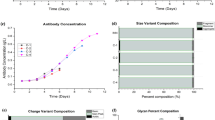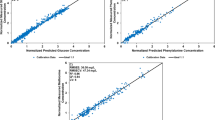Abstract
Hybridoma 130-8F producing anti-F monoclonal antibodies (MAb) were grown in batch and fed-batch mode with glutamine as the limiting substrate. The initial concentration of glucose varied between 10 and 25 mM but was not growth limiting. Monoclonal antibody production was identified as being partially growth associated. Employing the cumulative cell hour concept, external metabolic flux estimates were calculated during the exponential growth phase for MAb, glucose, amino acids, ammonia and lactate. Through nutritional profiling using principal component analysis (PCA) followed by partial least squares regression (PLS), key metabolites were identified and grouped for significant positive, significant negative, low level, and negligible correlation to MAb production, cellular growth, glucose consumption, and ammonia and lactate production. Significant relationships peculiar to Hybridoma 130-8F were identified, such as demand for two normally non-essential amino acids (asparagine and aspartic acid), and the positive correlation between MAb and ammonia production.



Similar content being viewed by others
Abbreviations
- ch:
-
Cell hours
- CHvol :
-
Volumetric cell hours
- ELISA:
-
Enzyme linked immunosorbent assay
- MAb:
-
Monoclonal antibodies
- PCA:
-
Principal combonent analysis
- PLS:
-
Partial least squares regression
- X t :
-
Total cell concentration
- X V :
-
Viable cell concentration
- Δt :
-
Change in time
References
Alter O, Brown PO, Botstein D (2000) Singular value decomposition for genome-wide expression data processing and modeling. Proc Natl Acad Sci 97(18):10101–10106
Anderson LJ, Hierholzer JC, Tsou C, Hendry RM, Fernie BF, Stone Y, McIntosh K (1985) Antigenic characterization of respiratory syncytial virus strains with monoclonal antibodies. J Infect Dis 151(4):626–633
Bakker WAM, Schäfer HH, Beeftink JT, De Gooijer CD (1996) Hybridomas in a bioreactor cascade: modeling and determination of growth and death kinetics. Cytotechnology 21:263–277
Barford JP, Phillips PJ, Marquis CP, Harbour C (1996) Biosynthesis of protein products by animal cells. A re-growth and non-growth associated concepts valid or useful? Cytotechnology 21:133–148
Batt BC, Kompala DS (1989) A structured kinetic modeling framework for the dynamics of hybridoma growth and monoclonal antibody production in continuous suspension cultures. Biotechnol Bioeng 34:515–531
Bibila TA, Flickinger MC (1991) A structured model for monoclonal antibody synthesis in exponentially growing and stationary phase hybridoma cells. Biotechnol Bioeng 37:210–226
Chen T, Hsu YJ, Liu X, Zhang W (2002) Principle component analysis and its variants for biometrics, IEEE ICIP
Dalili M, Ollis DF (1988) The influence of cyclic nucleotides on hybridoma growth and monoclonal antibody production. Biotechnol Lett 10:781–786
Dalili M, Sayles GD, Ollis DF (1990) Glutamine-limited batch hybridoma growth and antibody production: experiment and model. Biotechnol Bioeng 36:74–82
Dhir S, Morrow KJ, Rhinehart RR, Wiesner T (2000) Dynamic optimisation of hybridoma growth in a fed-batch bioreactor. Biotechnol` Bioeng 67:197–205
Dutton RL (1998) Growth and productivity of a recombinant Chinese Hamster ovary cell line in batch culture. University of Waterloo
Dutton RL, Scharer JM, Moo-Young M (1998) Descriptive parameter evaluation in mammalian cell culture. Cytotechnology 26:139–152
Franco-Lara E, Weuster-Botz D (2005) Estimation of optimal feeding strategies for fed-batch bioprocesses. Bioprocess Biosyst Eng 27:255–262
Jang JD, Barford JP (2000) An unstructured kinetic model of macromolecular metabolism in batch and fed-batch cultures of hybridoma cells producing monoclonal antibody. Biochem Eng J 4:153–168
Jeong YH, Wang SS (1995) Role of glutamine in hybridoma cell culture: effects on cell growth, antibody production, and cell metabolism. Enzyme Microb Technol 17:47–55
Johansson D, Lindgren P, Berglund A (2003) A multivariate approach applied to microarray data for identification of genes with cell cycle-coupled transcription. Bioinformatics 19(4):467–473
Ljunggren J, Häggström L (1995) Specific growth rate as a parameter for tracing growth-limiting substances in animal cell cultures. J Biotechnol 42:163–175
Mandenius C-F (2004) Recent developments in the monitoring, modeling and control of biological production systems. Bioprocess Biosyst Eng 26:347–351
Miller WM, Blanch HW, Wilke CR (1988) A kinetic analysis of hybridoma growth and metabolism in batch and continuous suspension culture. Effect of nutrient concentration, dilution rate, and pH. Biotechnol Bioeng 32:947–965
Nielsen J, Emborg C, Halberg K, Villadsen J (1989) Compartment model concept used in the design of fermenation with recombinant microorganisms. Biotechnol Bioeng 34:478–486
Phatak A, de Hoog F (2002) J Chemometr 16:361–367
Pörtner R, Schäfer T (1996) Modelling hybridoma cell growth and metabolism—a comparison of selected models and data. J Biotechnol 49:119–135
Sanderson CS, Jang JD, Barford JP, Barton GW (1999) A structured, dynamic model for animal cell culture systems: application to murine hybridoma. Biochem Eng J 3:213–218
Stephanopoulos G, Nielsen J, Aristidou A (1998) Metabolic engineering: principles and methodologies. Academic, Sand Diego
Suzuki E, Ollis DF (1989) Cell cycle model for antibody production kinetics. Biotechnol Bioeng 34:1398–1402
Tatiraju S, Sorous M, Mutharasan R (1999) Multi-rate nonlinear state and parameter estimation in a bioreactor. Biotechnol Bioeng 63:22–32
Xie L, Wang DIC (1994) Fed-batch cultivation of animal cells using different medium design concepts and feeding strategies. Biotechnol Bioeng 43:1175–1189
Zhang L, Shen H, Zhang Y (2004) Fed-batch culture of hybridoma cells in serum-free medium using an optimized feeding strategy. J Chem Technol Biotechnol 79:171–181
Zhou W, Chen CC, Buckland B, Aunins J (1997) Fed-batch culture of recombinant NSO myeloma cells with high monoclonal antibody production. Biotechnol Bioeng 55:783–792
Author information
Authors and Affiliations
Corresponding author
Additional information
Industrial Sponsor: Sanofi Pasteur (formerly Aventis Pasteur), Toronto, Canada.
Rights and permissions
About this article
Cite this article
De Alwis, D.M., Dutton, R.L., Scharer, J. et al. Statistical methods in media optimization for batch and fed-batch animal cell culture. Bioprocess Biosyst Eng 30, 107–113 (2007). https://doi.org/10.1007/s00449-006-0107-7
Received:
Revised:
Accepted:
Published:
Issue Date:
DOI: https://doi.org/10.1007/s00449-006-0107-7




